New "Streamer" Video Obtained by Basin & Range Watch of Crescent Dunes Solar Project Birds Vaporizing
Investigative Report: More Bird Deaths in Solar Flux, Problem Not Solved
By Laura Cunningham and Kevin Emmerich
UPDATE: September 1, 2016 - article in EENEWS http://www.eenews.net/stories/1060042210
UPDATE: November 10, 2015 - Bureau of Land Management (BLM) just informed us that to obtain the actual monthly avian monitoring reports themselves the public information officer for Solar Reserve said the company still considers these documents to contain proprietary information. Therefore if we want copies of the individual monitoring reports, we will still need to file requests under the Freedom of Information Act so that the BLM can review the documents and make a determination regarding the need to redact any proprietary information before they are released.
October 27, 2015 - Near Tonopah NV - The Ivanpah Solar Electric Generating System power towers have made the news in bird mortality as the intense solar flux creates damaging heat energy to anything that flies through it over formerly biodiverse Mojave Desert habitat in a valley surrounded by bird-rich mountain ranges. Now Basin & Range Watch has obtained a video through Freedom of Information Act Request that shows biologists contracted by SolarReserve filming and commenting on numerous birds flying into solar flux, apparently horned larks, turning white-hot, and vaporizing. This video is from last January during testing when mirrors were focusing solar flux in a "halo" pattern in standby position above and around the tower creating a deadly ring of bird-trapping flux. SolarReserve has replied since then they "fixed" the problem by rearranging the mirrors to create a less intense "pancake" pattern.
From the Las Vegas Review-Journal last March:
Company spokeswoman Mary Grikas said the bird deaths occurred during early testing when the plant was in “standby” mode, mirrors focused on a single point in the sky above the central heating tower and creating a bright spot in the air.
During normal operations, the plant might spend a few minutes in standby mode, but on Jan. 14, it remained that way for several hours, she said.
Project engineers since have developed a way to direct the mirrors in standby mode to spread the beam over hundreds of yards rather than training it on a single spot, resulting in a field of light safe for birds to travel through.
“Once the mirrors are focused on the tower, the brightness and solid structure is enough to deter birds,” Grikas said.
We disagree with the last sentence. At the Ivanpah solar power towers birds are being killed as they fly through the smaller cone of very intense solar flux during operation of the facility, and are not being deterred by the brightness. The real problem is the operational solar flux, not solar flux during testing when the mirrors are aimed in different configurations around the power tower. During operation, when all mirrors are aimed at the receiver on top of the tower, a high-energy solar flux cone. Simply changing testing configurations does nothing to mitigate the solar flux created in the air space around the tower during normal operation, when temperatures are hot enough to super-heat fluids such as molten salt (as at Crescent Dunes) or water into steam (as at Ivanpah).
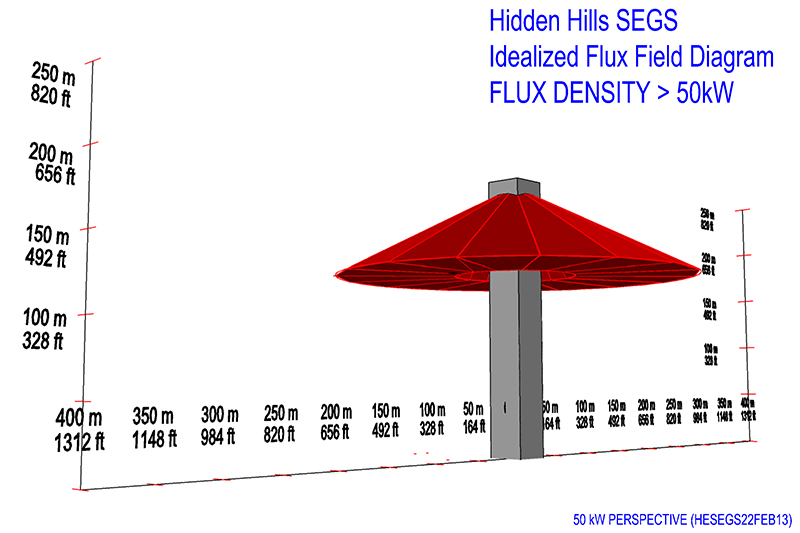
^California Energy Commission (CEC) diagram of the most intense 50 kiloWatt per square meter operational solar flux that would be generated at a solar power tower such as proposed at Hidden Hills. This is the bird-killing flux that is the type that vaporizes birds flying through it, as shown by the video. This model is not even for a solar power tower with storage, which might need a larger solar field and thus have even more intense solar flux to heat storage tanks.
^Cone-shaped solar flux of high intensity as in the above 50 kiloWatt per square meter diagram, at Ivanpah Solar Electric Generating System during operation. How do you mitigate the "cone"? Birds still fly through it.
The photo below shows the solar flux photographed in April 2015 at Crescent Dunes where mirrors are not aimed directly at the tower but in a testing configuration around it. This is not operational solar flux.
^Solar flux in testing last April mode aimed at standby points in the sky (Photo by Jack Freer).
Even though the flux is not as hot as it would be focused directly at the tower receiver, evidence has accumulated from California Energy Commission proceedings for the Hidden Hills solar power tower project, that birds will be singed, burned, and blinded by flying through the edges of the solar flux, whether during testing or operation, because it still carries a high energy content.
SolarReserve tried to explain how they mitigated this testing flux to lessen bird deaths:
"We had some avian incidents during the week of January 11, in which there were a number of incidents, estimated at under 150 avian safety issues," SolarReserve CEO Kevin Smith told Rewire. "As a result, we stopped testing until we successfully developed mitigation procedures to address the identified avian safety issues."
Those mitigation procedures, developed by SolarReserve's engineers, include repositioning the plant's mirrors to reduce the intensity of the solar flux field. (From KCET ReWire)
Even if changes were made to the configuration of the testing solar flux, we are not convinced birds would be safe. The diagrams below show CEC models of the less intense solar flux at the edges of the solar field, with the same intensity as parts of a testing configuration. These energy levels will still injure birds, singe feathers, and possibly cause blindness, according to CEC staff.

^CEC diagram of less intense operational flux around a power tower. This is the type of flux that can still burn and singe a bird.

^CEC diagram of operational solar flux of a lesser intensity (5 kiloWatts per square meter), that may singe feathers and possibly blind birds passing through it. Is this the level of intensity of even a mitigated "pancake" array during testing that SolarReserve says has fixed the problem? We need more information and more data collection that can be publicly scrutinized.
See the link for these diagrams:
Solar Flux
The heat energy from concentrated sunlight reflected off the mirrors converging at the top of the tower creates a risk for flying birds. CEC staff modeled the impacts to bird feathers on a dark-colored bird theoretically flying at a certain speed through the flux field that will form around the solar receiver during the day when the power plant is generating electricity.
Bird feathers are made of keratin, which are made of protein molecules. At 160 degrees Celsius the proteins begin to break down and this adverse effect begins to damage the feather. As a bird flies through the flux field, exposures at 5 kilowatts per square meter of radiant flux will cause irreversible damage to feathers. See the chart above, this is an extensive area.
For a 750-foot tower (as modeled for the Hidden Hills project), the 50 kW/m2 would have a flux radius of greater than 1,000 feet out from the tower. The flux field at 10 kW/m2 starts around 500 feet up and goes upwards of 1,000 feet in the air. This will create a hot air thermal as well, rising above that could attract golden eagles and other raptors which seek out such thermals for increasing flight height. Staff contends golden eagles and other birds will be killed by exposure to this flux field. The killing of even one protected species would be a significant impact.
So the problem is not fixed. We do not see how operational solar flux can be mitigated to prevent bird mortality.
Bird Deaths
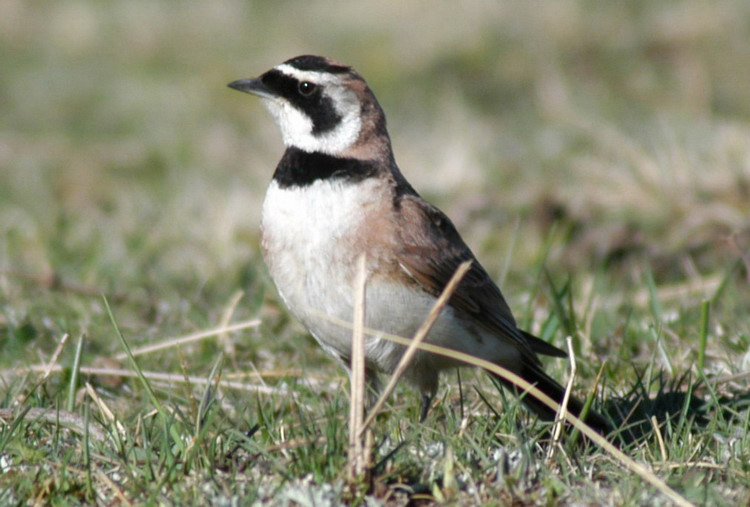
^Horned lark (Eremophila alpestris) (Photo by David Blank). We have visited the Crescent Dunes area several times, a broad flat sandy high desert area, and have seen flocks of horned larks flying overhead. They can fly several hundred feet up in the air space. This species may be the one indicated in the video flying through the solar flux.
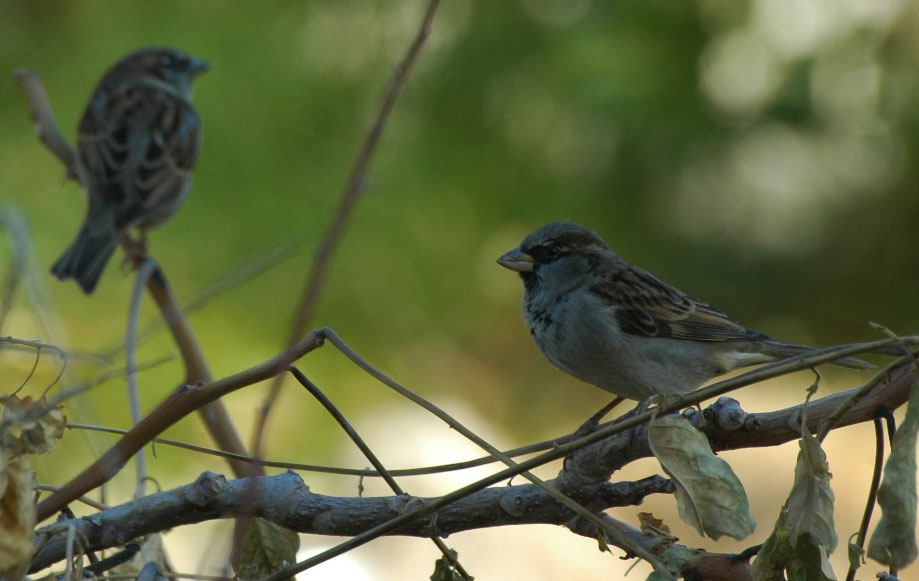
^House sparrows (Passer domesticus) are introduced birds from Europe that colonize human dwellings and buildings. They apparently followed the construction of the Crescent Dunes solar facility out into the open desert as opportunistic invasive birds that feed off food scraps and nest in buildings. House sparrows may have colonized the Ivanpah solar facility buildings as well. They fly low around the buildings usually, and may not be the main birds that are killed in solar flux.
But of concern is habitat around the solar project which may attract a diversity of other birds, including migratory passerines, raptors such as Swainson's hawks, and rare birds seen at nearby Miller's Rest Stop along US 95. Ephemeral wetlands adjacent to the solar plant could attract waterbirds, and uncovered evaporation ponds within the facility could attract them too close to solar flux.
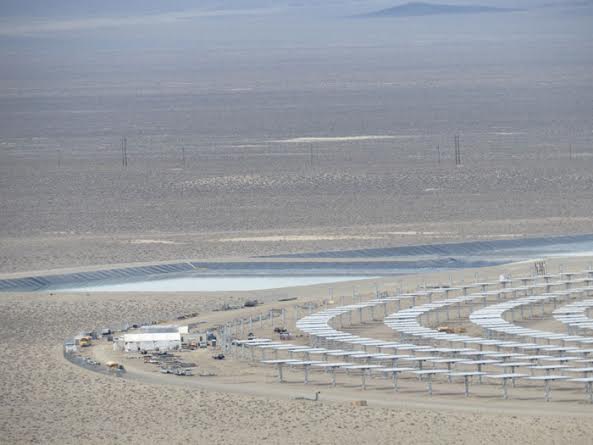
^Evaporation ponds at Crescent Dunes solar project. Will these attract birds?
There are many unanswered questions concerning bird mortality at these solar projects.

^Horned larks flying. (Photo by Bob Steele).
Still crops from the video, showing an apparent horned lark flying into the solar flux, turning white hot, and falling apart before disappearing:
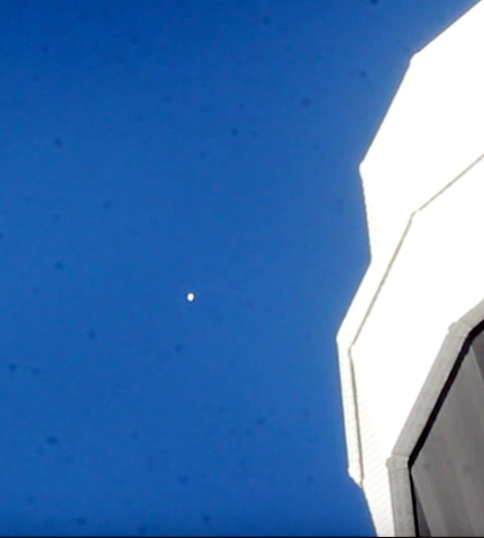
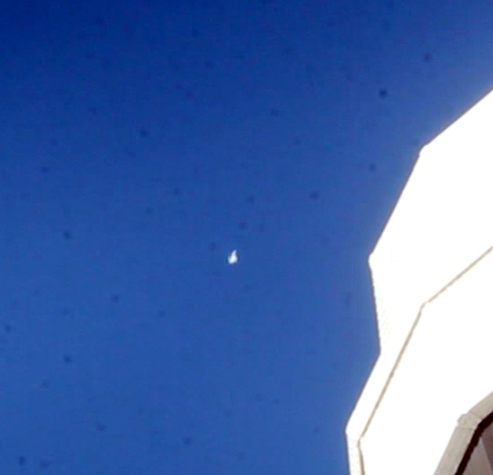
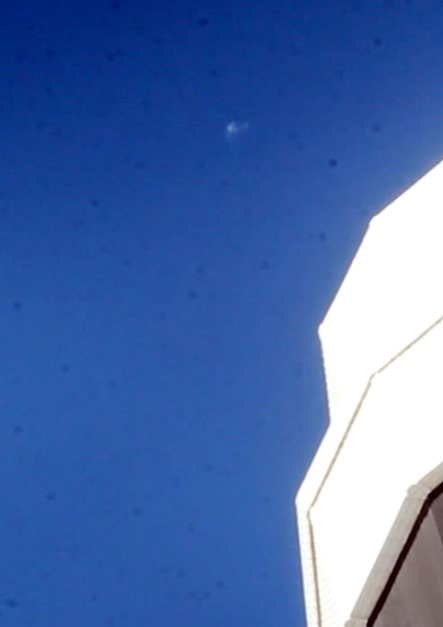
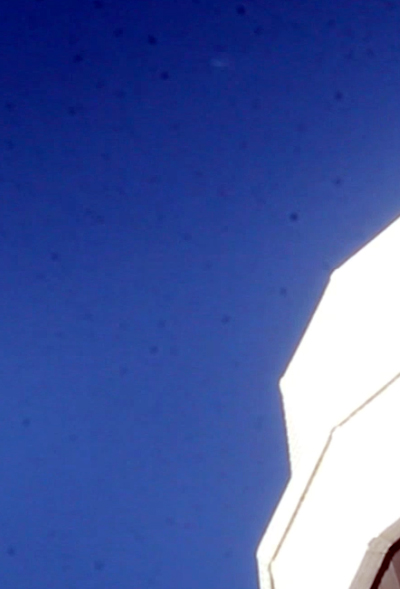
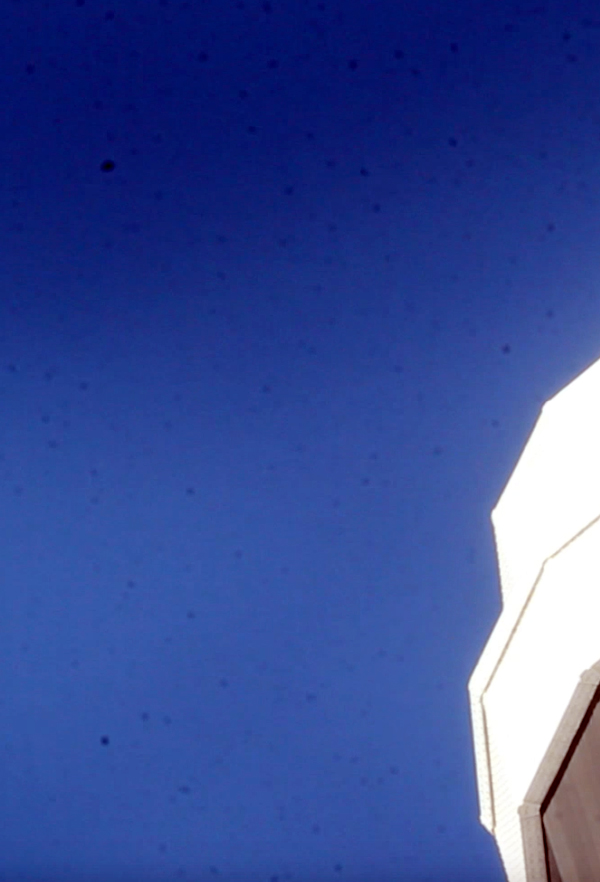
^In the last frame, the bird is gone. There may not be any remains on the ground to detect during mortality surveys for carcasses.
Solar Reserve Responds
During a March 2015 Facebook post on the Crescent Dunes Solar Energy Project in which Basin & Range Watch Questioned whether mitigation measures aimed at preventing bird deaths in the solar flux would help prevent more deaths. Solar Reserve responded in the comments:
SolarReserve: We are simply reporting the facts. The testing continues to be monitored by a team of independent environmental consultants (including biologists), who are carefully watching the airspace around the tower with high powered binoculars at all times during testing – and who report directly to the BLM. This independent team has reported zero bird fatalities (to the BLM) in the last 45 days. (Feel free to post those reports as well as the earlier report you posted.) The fact is that we halted testing and our engineers worked to solve the problem. Just to be clear, all industrial facilities have risk to birds. The tower is like a building (although no windows, which helps) so there are still some risks to birds flying into the tower like they do into buildings that can't be fully eliminated. However, we have made the necessary changes so the risks are greatly reduced and not caused by the "solar aspect" of the facility. Our fundamental goal at SolarReserve is to help protect our planet for wildlife and people for generations to come.
SolarReserve, in consultation with BLM, NDOW and USFWS created an Avian and Bat Protection Plan (ABPP) to mitigate any potential avian impacts from Crescent Dunes. This program, which was approved in 2011 by the agencies listed above, is intended to reduce the potential for avian and bat mortality, report and isolate events if mortality occurs and assist in compliance with applicable laws and regulations. According to the ABPP, once commercially operational the Crescent Dunes facility is required to perform monthly mortality surveys, reporting results to BLM and NDOW. Additionally, as a part of the BLM Right of Way stipulations, independent on-site inspectors (including biologists) have been on-site daily since the start of construction – reporting directly to the BLM. It is important to note that SolarReserve proactively decided to start the approved ABPP monthly mortality surveys prior to commercial operations – which is how we were made aware of the issues during early testing. We have had environmental biologists on-site, monitoring activities and reporting to the BLM since August, 2011 and have been conducting monthly mortality surveys for over a year now. This environmental consultant providing the biologists, Stantech, reports its findings directly to the BLM, but funding is provided by SolarReserve. As stated previously, the biologists are monitoring the tower area with high powered binocular constantly during testing. As for on-the-ground testing, searches are performed by essentially 4 groups. The first group is the environmental biologists who report their results directly to the BLM. This group has been on-site daily since August 2011, observing construction activities and wildlife, and reporting to the BLM weekly. The second group has been on site since early March of last year performing 7-day avian mortality surveys each month. During that week, 1/8th of the heliostat field, 1/8th of the evaporation pond and 1/8th of the transmission line corridor is searched – and then the following month another section (or transect) is searched, resulting in completing a search of the entire facility about every 8 months. The third group is the Great Basin Bird Observatory, who was contracted by the BLM. They have had 4-5 biologists on-site since September 2014, validating the ABPP mortality survey protocols with a completely independent set of mortality surveys. The fourth group is the field technicians who spend every day in the heliostat field working to test, operate and maintain the heliostats. Although, not biologists, they have been trained by biologists to look for and identify any wildlife mortalities. The protocol, if an mortality is encountered, is to photograph and GPS tag the body and report to the on-site biologist who will report to the appropriate agencies. The entire heliostat field has been complete for over a 15 months now, with all mirrors installed and in place. The workers are in the field all day, covering the entire site during the course of their responsibilities. There have been a small handful of mortalities found during this entire time – 4 were a direct result of Federally sanctioned poisoning of avian pests (primarily ravens) in a nearby County dump and the remaining 5 were consistent with predation from other local species.
We do not beleive that surveys only covering 1/8th of the solar field once a month will find all bird mortalities, especially since smaller passerine birds such as sparrows, swallows, and warblers, as well as bats, may be missed or scavenged by foxes, coyores, ravens, or other predators.
